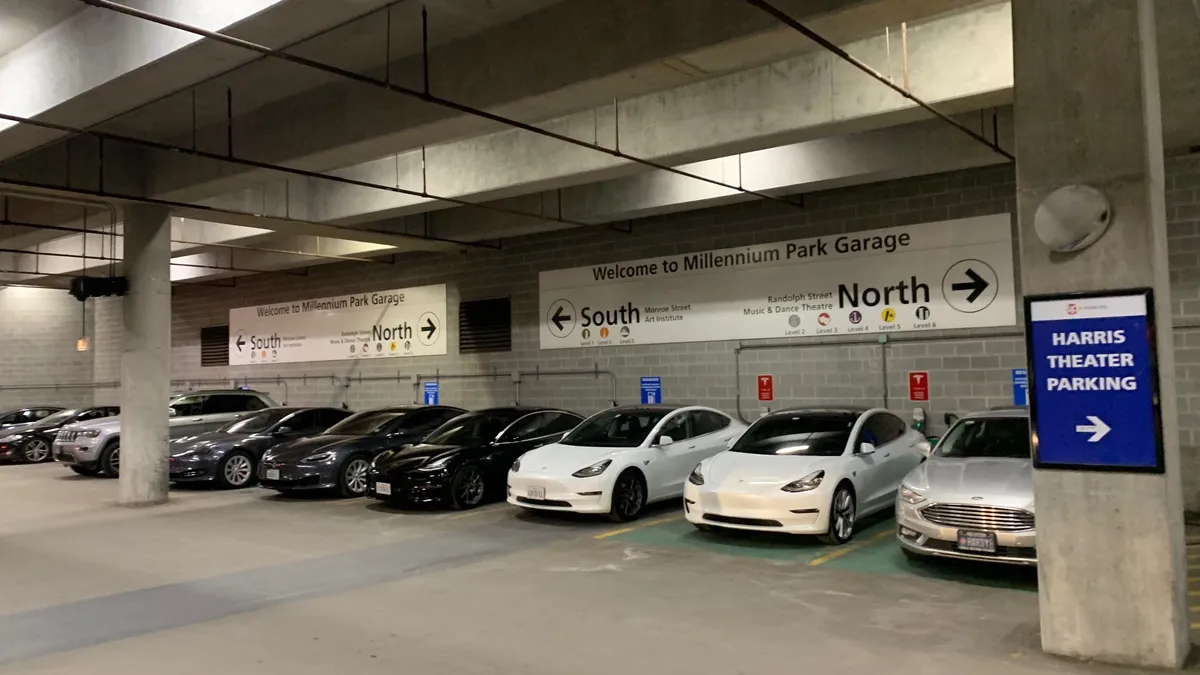Dive Brief:
- Adding charging facilities at retail and restaurant locations is one of the most profitable ways to increase EV infrastructure, a senior project manager at Atlas Public Policy said during a Wednesday webinar hosted by the Center for Climate and Energy Solutions that also featured representatives from Georgia Power and EVgo.
- Charging stations bring in new customers and increase how long they stay, which results in additional sales, said Atlas' Charles Satterfield, one of the panel moderators. He added that analyses done by Atlas and others show this indirect income is usually more significant than user fees from the charging itself.
- EVgo executive Jonathan Levy said the company has had particular success with grocery stores, and noted that most retailers seem to get the best results with DC fast chargers rather than slower Level 2 chargers.
Dive Insight:
Retail businesses could hold the key to achieving sustainable growth of electric vehicles — but they may need a boost to encourage adoption in some areas, panelists concluded during a Wednesday webinar hosted by the Center for Climate and Energy Solutions.
More sustainable business models are needed to support the adoption of EV charging stations to bring the needed infrastructure in line with demand generated by rising EV adoption, said Satterfield.
"The EV market is rapidly expanding in the U.S.," Satterfield said, "but charging infrastructure has not necessarily kept pace. There is a gap between EVs on the road and the infrastructure needed to support them. That gap will likely widen with time, but one way to fill that gap is using retailers as potential site hosts for EV charging."
Locating EV charging stations in retail and restaurant parking lots offers one of the most profitable potential business models for EV charging, he said. Charging stations not only attract new customers, Satterfield said, but also increase the amount of time customers spend patronizing a business, which results in additional sales.
In models run by Atlas and other researchers, Satterfield said, this indirect income is typically "more significant than user fees" and may account for half the income generated by the installation of EV chargers. Charging fees may represent the other half, he said, but in most cases only generate enough income to cover the operating costs associated with the chargers.
Jonathan Levy, senior vice president of EV charging company EVgo, said he frequently hears from retail businesses that want to install chargers in their parking lot as a means of attracting customers.
"We heard from a strip mall owner who wanted fast charging at their location," Levy said. After the install, he said, the owner reported that he "now has additional clientele to the strip mall. We see that time and time again, businesses saying, 'this is great, we now have additional customer draw.'"
DC fast chargers rather than slower Level 2 chargers typically offer the best results, Levy said.
"We've had examples where fast chargers and Level 2 chargers are co-located, and we got feedback that it wasn't working," he said. "One said they had a guy who drives in every day, drops off his car to charge, and takes the bus to work," without patronizing the business.
Levy acknowledged that this model is more challenging in rural communities with lower rates of EV adoption. "Public policy is really helpful to push out that development, because it's not often economic just by itself," he said.
Todd Allums, an electric transportation specialist with Georgia Power, said the Atlanta-based utility has seen success in installing "community charging stations" in areas without charging infrastructure. The company also has a cost-sharing program for businesses that would like chargers installed on their property, but may not be able to afford the upfront cost.
Satterfield said grants and other kinds of one-time funding can help establish EV charging infrastructure, but cautioned that previous studies have shown they do little to support the profitability of a station long-term.
"Grant funding is important to provide a floor for profitability," he said, "but it did little to raise the ceiling compared to other factors such as increasing customer dwell time."













